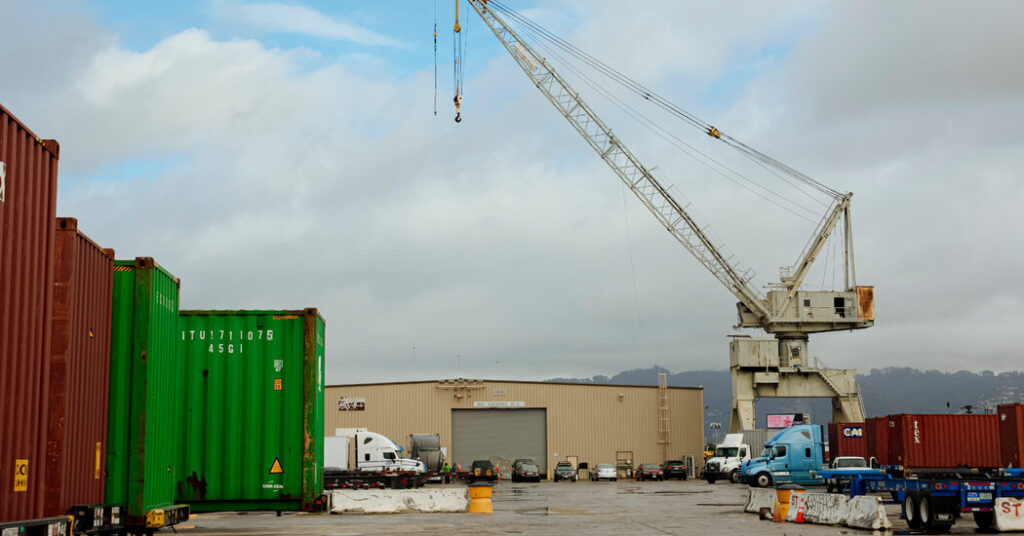It could turn out to be the costliest story ever written in a Utah weekly newspaper.
In April 2015, the Richfield Reaper covered a new initiative to export Utah coal through a port in Oakland, Calif., and across the Pacific Ocean. The story found its way to Bay Area environmentalists, who quickly circulated the piece and were outraged that Oakland’s waterfront could become a conduit for shipping fossil fuels overseas.
What followed was a decade-long political and legal saga that ultimately could push the struggling City of Oakland toward bankruptcy.
Port activities have long been a driver of Oakland’s economy, with towering white cranes a signature sight along the shoreline. The city of 444,000 residents has the nation’s ninth busiest port, which unloads containers from Asia and ships American cargo across the Pacific.
Situated in one of the nation’s most politically liberal regions, Oakland’s seaport activities also have been an inevitable draw for progressive activists, given that the port serves as the East Bay’s link to the world. Over the years, there have been Occupy rallies and demonstrations against military shipments to Israel.
A decade ago, when environmental protesters banded together and convinced the city to renege on a contract allowing coal shipments from an Oakland terminal, it set off a chain of events that undermined a Kentucky coal company and left the city potentially liable for hundreds of millions of dollars. Since then, judges have ruled multiple times against Oakland, which is already plagued by serious financial problems.
“We lost, lost, lost, and we continue to lose,” said Ken Houston, a first-year Oakland city councilman who inherited the fallout from the city’s coal wars.
At the foot of the Bay Bridge, far below where cars zoom along the white ribbon rising over the water toward San Francisco, the Oakland Army Base once sent supplies and troops overseas during World War II, the Korean War and the Vietnam War. After the base was decommissioned in 1999, the city of Oakland received some of the land.
In 2013, the city gave permission to a local developer, Phil Tagami, to build a $250 million shipping terminal on that land. He then signed a lease with a company that planned to ship as many as 12 million tons of coal per year, according to court documents. It was set to become the largest coal export facility on the West Coast, opening up Asian markets as demand dipped domestically.
That is, until news of the plan broke in 2015.
“It became a cause célèbre overnight — this shocking development taking place with the former Oakland army base,” said Ted Franklin, one of the original organizers of No Coal in Oakland, a grass-roots organization that formed to fight the project.
Local activists and environmental groups, including the Sierra Club and Earthjustice, lobbied the Oakland City Council to stop coal from entering the city. Hundreds of “No Coal” demonstrators showed up to City Council meetings.
Though coal wouldn’t be burned in Oakland, toxic dust can be created when pieces jostle against each other, such as in a rail car or when conveyed onto a ship. And environmentalists were adamantly opposed to Oakland contributing to the use of more fossil fuels, which release greenhouse gas emissions that worsen climate change.
City officials, however, found themselves in a pickle. They had already approved a contract with Mr. Tagami to export bulk commodities from the terminal — and nowhere did it say coal was prohibited.
The officials, including then-Mayor Libby Schaaf, first tried to discourage Mr. Tagami behind the scenes. He refused.
“I believe in climate change,” said Mr. Tagami on a recent windy morning, standing with his back to choppy waters at the port. “This is a fraction of the seaborne coal market. You’re saying this makes the difference in the world? Oakland needs to balance its budget and fill its potholes.”
Nonetheless, the City Council acceded to public pressure and, in June 2016, unanimously passed an ordinance banning the transport and storage of large coal shipments in Oakland.
So Mr. Tagami sued the city of Oakland, and won. Twice.
A judge for the U.S. District Court for the Northern District of California, ruled in 2018 that Oakland officials didn’t have sufficient proof that coal shipments would harm residents, and instead had canceled Mr. Tagami’s contract over broader concerns about global warming. And a state judge also ruled in 2023 that the city had to uphold its deal with Mr. Tagami.
In September, Oakland exhausted its last legal option for appeal, and the coal project must now go forward. The city is currently looking at Mr. Tagami’s permits to begin construction, he said.
But the court saga isn’t over.
Last month, Bankruptcy Judge Joan A. Lloyd of the Western District of Kentucky ruled that Oakland’s “improper and unjustified conduct significantly disrupted and burdened” the Kentucky-based company that had been contracted to ship coal out of Oakland’s terminal, forcing it into bankruptcy.
The judge suggested the damages were between $654 million, before interest — what the coal company is pushing for — and $230 million, what Oakland’s own expert estimated the coal company had lost.
A federal district judge is reviewing the ruling, and the city is urging him to reject it. But district judges often affirm bankruptcy court decisions, and if that happens, a Kentucky jury likely would determine next year the exact damages that the city of Oakland would owe.
In a statement, the Oakland city attorney’s office said it looked forward to the results of the higher court judge’s independent review. As for the prospect of the city filing for bankruptcy, the office said that such speculation “would be premature at this time.”
David Levine, a professor at University of California College of the Law, San Francisco, who specializes in remedies, said that if Oakland must pay damages, it could likely do so in installments over a decade because it is a municipality. It could raise taxes or issue bonds, paying interest to plaintiffs and bondholders, but neither might be possible because the city has so little cash.
“It’s an amazing losing streak,” said Mr. Levine. “The specter of bankruptcy for Oakland is not off the table.”
Oakland has struggled with a yawning budget deficit since the pandemic and the City Council recently approved cuts in a two-year budget to close a $265 million gap. An Alameda County grand jury report this year found that the city didn’t issue any bonds in 2024 because of its poor finances.
“Oakland’s financial situation is so precarious that insolvency may be closer than the city’s elected officials have been willing to acknowledge publicly,” the report states.
Seneca Scott, a political organizer who ran for Oakland mayor in 2022, said that he was less concerned about the potential health harms from the coal project than about the financial fallout from litigation. He lives in West Oakland, a low-income neighborhood where the terminal sits and where any coal pollution would likely be concentrated.
“We’re already on the razor’s edge of fiscal insolvency,” he said. “Whatever is going to happen, it isn’t going to be good, and the people who suffer are once again the people in Oakland paying taxes.”
Over the past year, all three major credit rating agencies downgraded Oakland. Pascal St. Gerard, an analyst at Fitch, said in an interview that the city’s ongoing budget deficit and lack of a plan to resolve it led to the recent reduction, but he was also monitoring the coal lawsuit.
Sarah Sullivant, an analyst at Standard & Poor’s, said she believed Oakland’s financial picture had improved, albeit slowly, with new leadership in recent months, and she did not think the city would have to pay out the amount of damages that had been claimed.
Dan Lindheim, who worked as city administrator of Oakland during the Great Recession, said the city likely has insurance that could cover some damages owed. But a major payout in the coal case could force the city into a precarious position.
“It would be a ton of money that the city doesn’t have,” he said.
Still, environmentalists said that they and city leaders were right to fight the coal project. Dan Kalb, a former Oakland City councilman who proposed the original coal ban, said that he and his colleagues thought their case had been strong enough to prevail in court.
“Sometimes you think one thing and it turns out the other way in court,” Mr. Kalb said.
Anyone who understands the risks of climate change as well as coal-related air pollution “can’t in their right mind want to ship and then burn so much coal,” he added. “It’s just nuts. How could someone say they care about future generations and then do this?”
Sejal Choksi-Chugh, the executive director of San Francisco Baykeeper, also applauded the city of Oakland for doggedly pursuing the fight against coal. She called the council’s efforts to protect public health “courageous,” even as the financial toll has mounted.
“Cost is not the only thing that cities should be considering,” she said.
On that recent morning, Mr. Tagami navigated between cargo trucks and under cranes as he walked the 19-acre parcel along the waterfront where he proposed building a shipping terminal more than a decade ago. He said that despite the fuss, he did not regret signing the deal with the city.
And in the end, the City Council might only have delayed matters. Mr. Tagami said he expects cargo ships could depart from Oakland as soon as 2027 carrying coal overseas.
Soumya Karlamangla is a Times reporter who covers California. She is based in the Bay Area.
The post A Stand Against Coal Could Push Oakland Toward Bankruptcy appeared first on New York Times.




